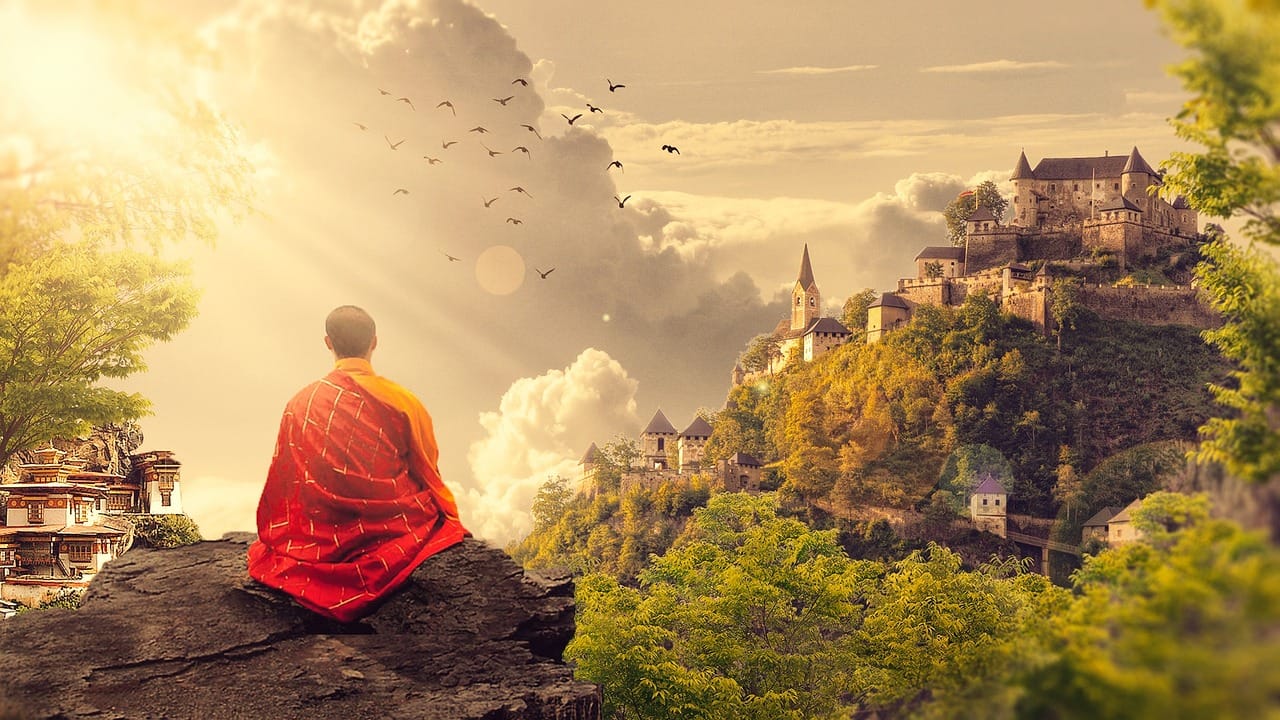MEDITATION

Sleep better, reduce stress and anxiety, and feel happier about your life. If you yearn for simpler calmer days, settle yourself down to explore the rich tradition of meditation for your modern life. Explore meditation to gain insight and understanding of the biggest stressors of our time.
The Beginnings of Mindfulness Meditation
Mindfulness meditation can be traced back to the first written records of yogic meditation in the Vedas. The ancient practice of yoga involved very little reference to postures and placed a greater emphasis on stillness, a focus on breathing, and being fully aware of the body in the present moment.
Mindfulness has also been traced back to the early Buddhist practice of Satipaṭṭhāna and Daoism, both of which include a strong focus on breathing and self-awareness.
The practice of Satipaṭṭhāna involves the cultivation of tranquil observation to gain insight into impermanence, the first stage on the path to liberation. Meanwhile, the Daoist practice of Guan Meditation involves acute observation grounded in a similar state of awareness.
Many other religions include contemplative prayer and meditation techniques that require the individual to turn away from thoughts in search of greater self-awareness and presence. All these forms of meditation are very closely aligned with the practice and purpose of mindfulness.

A Brief History of Transcendental Meditation
Transcendental Meditation (TM) is a meditative practice that involves the repetition of a sound, called a mantra, for 15–20 minutes at least twice a day. TM helps the practitioner move into a state of relaxed awareness.
The Indian Guru Maharishi Mahesh Yogi established the technique in the 1950s. Maharishi was a follower of Swami Brahmananda Saraswati, the spiritual leader of Jyotirmath in the Indian Himalayas. Maharishi credited Brahmananda Saraswati with inspiring most of his teachings and the development of Transcendental Deep Meditation, later renamed Transcendental Meditation.
In 1955, Maharishi began teaching TM in India and quickly developed a following. Then, between 1955 and 1965, he undertook multiple global tours to spread his teachings. TM gained further popularity in the 1970s, with celebrities promoting the practice. During this time, Maharishi also began to train others as teachers and founded an international network of dedicated TM centers.
What Is Vipassana Meditation?

Vipassana is one of the oldest Buddhist meditation practices and can be roughly translated to mean “insight” — an awareness of what is happening, exactly as it happens. This is the core distinction between Vipassana meditation and other techniques.
The two core forms of early Buddhist meditation are Vipassana and Shamatha practices. Shamatha is roughly translated as “calm abiding,” when the mind is brought to rest rather than wandering from thought to thought. Shamatha meditation trains the individual to attain tranquility by focusing on an object — often the breath, a candle, or an image — to the exclusion of other thoughts.
As a meditative technique, Vipassana is very gradual, and achieving liberation can take many years. The technique is gentle but extremely thorough. The purpose is to retrain your mind to gain a deep state of awareness of everything that is happening, as it is happening, and exactly how it happens. Through Vipassana meditation, the practitioner is seeking to create a perfect, unbroken awareness of reality.
- Breathe deeply. This is good for beginners because breathing is a natural function.Focus all your attention on your breathing. Feel your breath and listen to it as you inhale and exhale through your nostrils. Breathe deeply and slowly. When your mind wanders, gently return your focus to your breathing.
- Scan your body. When using this technique, focus attention on each part of your body. Become aware of how your body feels. That might be pain, tension, warmth or relaxation.Mix body scanning with breathing exercises and think about breathing heat or relaxation into and out of the parts of your body.
- Repeat a mantra. You can create your own mantra. It can be religious or not. Examples of religious mantras include the Jesus Prayer in the Christian tradition, the holy name of God in Judaism, or the om mantra of Hinduism, Buddhism and other Eastern religions.
- Walk and meditate. Meditating while walking is a good and healthy way to relax. You can use this technique anywhere you're walking, such as in a forest, on a city sidewalk or at the mall.When you use this method, slow your walking pace so that you can focus on each movement of your legs or feet. Don't focus on where you're going. Focus on your legs and feet. Repeat action words in your mind such as "lifting," "moving" and "placing" as you lift each foot, move your leg forward and place your foot on the ground. Focus on the sights, sounds and smells around you.
- Pray. Prayer is the best known and most widely used type of meditation. Spoken and written prayers are found in most faith traditions.You can pray using your own words or read prayers written by others. Check the self-help section of your local bookstore for examples. Talk with your rabbi, priest, pastor or other spiritual leader about possible resources.
- Read and reflect. Many people report that they benefit from reading poems or sacred texts and taking a few moments to think about their meaning.You also can listen to sacred music, spoken words, or any music that relaxes or inspires you. You may want to write your thoughts in a journal or discuss them with a friend or spiritual leader.
- Focus your love and kindness. In this type of meditation, you think of others with feelings of love, compassion and kindness. This can help increase how connected you feel to others.
Building your meditation skills
Don't judge how you meditate. That can increase your stress. Meditation takes practice.
It's common for your mind to wander during meditation, no matter how long you've been practicing meditation. If you're meditating to calm your mind and your mind wanders, slowly return to what you're focusing on.
THINGS YOU MAY NOT KNOW: What is the age of meditation?
The earliest documented records that mentioned meditation involved Vedantism, which is a Hindu tradition in India, around 1500 BCE. However, historians believe that meditation was practiced before this time, as early as 3000 BCE.
THINGS YOU MAY WANT TO SAVE: Your computer brain full of gunk and useless information put on a disc and delete and begin daily meditation.
ZENTRAVELER SAYS: Start daily meditation forget mediahype and watch the world go by? Guess what you dont need any fancy meditation programs or gurus from India. Its free and you can meditate anywhere ....near a busy highway, at a long red light, close to railroad tracks or your choice of meditation sanctuaries.
From here to Infinity is a relatively short ride! The next leg takes eons and eons as you fly through the Barycentric Dynamical Time Zone! …and on and on and on. Follow the Zentraveler Newsletter often for Travel, Health and Zen-like stories and such. Where else can you get a THREE IN ONE NEWSLETTER FOR THE PRICE OF FREE.

ZENTRAVELER IS A PERSONAL NEWSLETTER, DESIGNED TO GIVE TRAVEL, HEALTH, WRITING AND HUMOR INCLUDING HELPFUL HINTS WITH A ZEN LIKE QUALITY.
PLEASE CHECKOUT MY NEW VIDEO PODCASTS AT ZENTRAVELER ON YOUTUBE...THANKS
